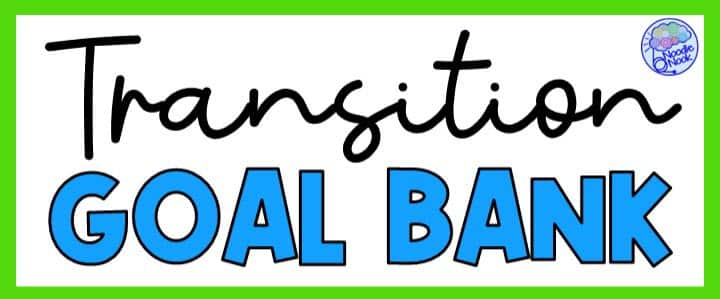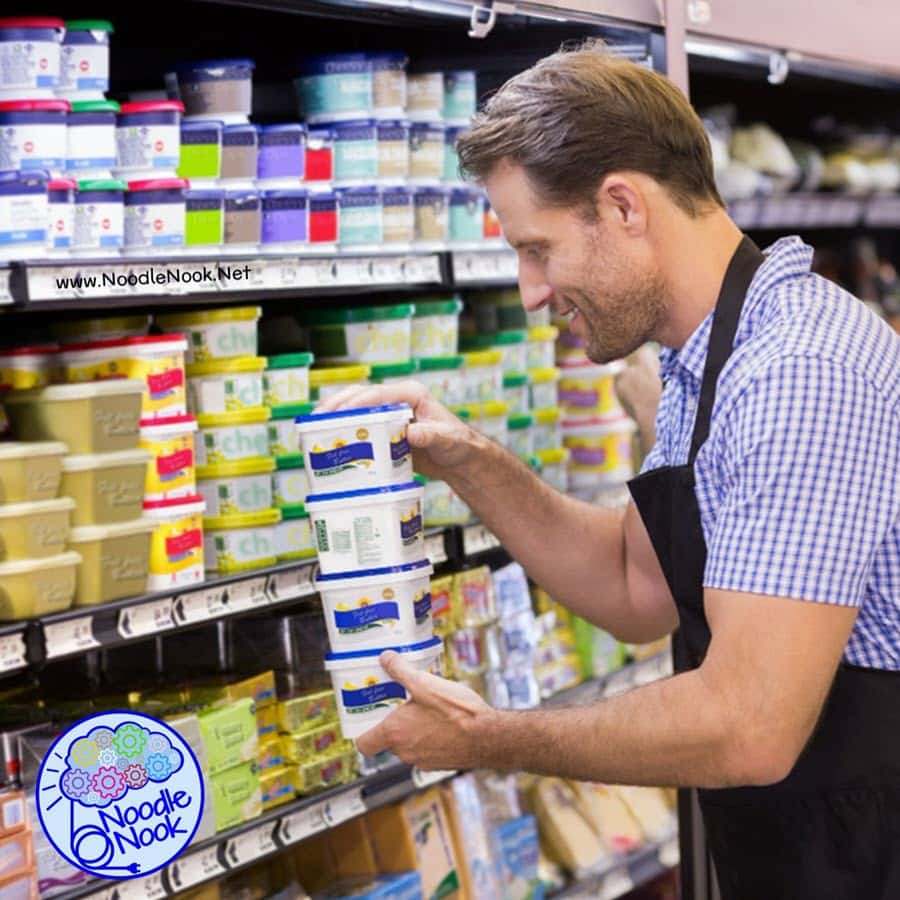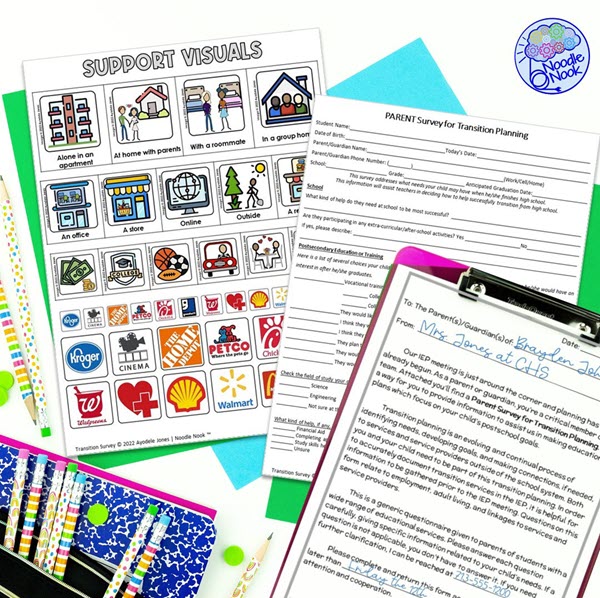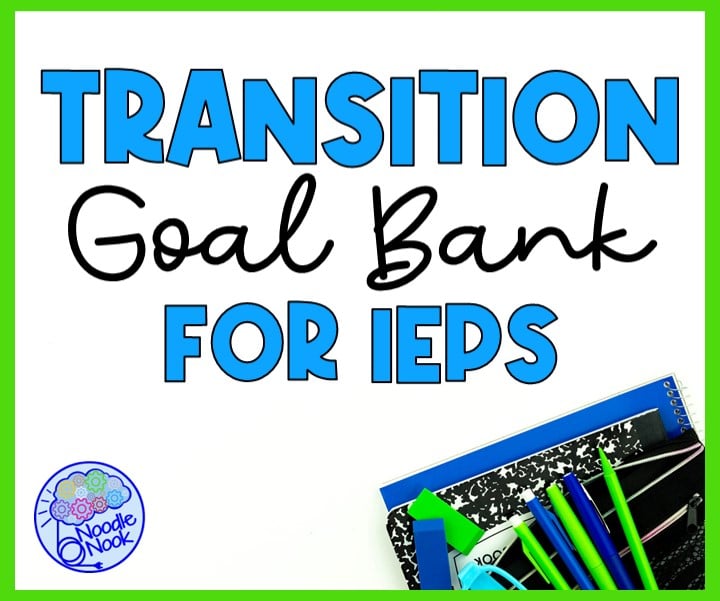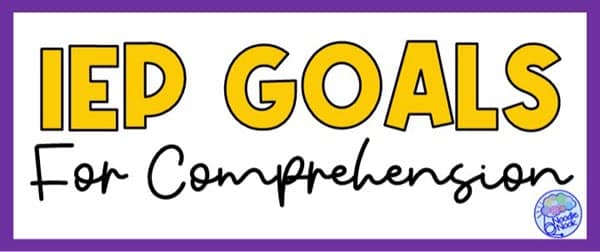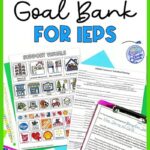Are you tired of reinventing the wheel every time you sit down to write transition IEP goals for the young adults on your caseload? No worries, We got you covered with these IEP transition goals bank! Bookmark this article so that you have easy access to transition planning ideas and postsecondary goals. This is a wealth of information for any IEP team member who is writing annual goals for high school students that focus on preparing for life after graduation!
What are Transition Goals for Students with Disabilities?
Transition goals are an important aspect of an Individualized Education Plan (IEP) for students with disabilities. They help bridge the gap between the academic world and the real world. These goals are a critical part of the transition process to ensure students are set up for success after they leave the educational system.
Transition goals focus on preparing students for life beyond the classroom. They cover areas such as employment, further education, independent living skills, and community involvement. These goals are individualized to each student and take into account their unique needs, strengths, and areas of interest. By having clear and specific goals in place, students with disabilities can feel confident and empowered as they enter adult life.
Why Write Transition Goals for Older Students?
Writing transition goals for older students with disabilities is an important step in preparing them for their future. As students approach adulthood, it becomes crucial to help them develop the skills and knowledge they need to live as independently as possible. Transition goals help to focus the student’s education on the skills they will need in the real world, such as finding and maintaining employment, managing finances, and navigating community resources.
By writing these goals and tracking progress, educators and families can ensure that students with disabilities receive the support they need to successfully transition into adulthood. This can include connecting to specific transition services or developing the life skills a student needs. Plus, having meaningful and purposeful transition goals in place can give students with disabilities a sense of direction and purpose, and help them see the possibilities for their future.
At What Age Do You Start Writing Transition Goals?
It’s never too early to start thinking about transition goals for students with disabilities. Ideally, transition planning should begin by the time students reach 14 years of age, as required by the Individuals with Disabilities Education Act (IDEA). However, the exact age at which transition goals should be written will vary depending on each student’s individual needs and abilities. For the most part, students in middle school and high school should be participating in transition planning and have transition as part of their IEP.
For some students, focusing on vocational skills, secondary education, and independent living starts as early as elementary school. The key is to start the transition planning process early enough so students have the time and support they need to achieve their goals. It’s also best to use age-appropriate transition assessments to guide transition planning. Involving the student, their family, and educators in the process can ensure the goals are meaningful, relevant, and achievable. Remember, the purpose of transition planning is to help students with disabilities have success after they leave the K-12 school system. Do that with purpose.
What are the Components of a Good Goal?
Writing good goals is a critical part of the transition planning process for students with disabilities. When you read the goals on the transition page, they should feel like they capture the student as opposed to just being there for being there’s sake. A good goal is meaningful to the student, purposeful to help a student attain more independence, and individualized for them. It’s a roadmap to their success!
When writing a transition goal, it should be a SMART goal. When we write post-secondary goals this way, then the goal statement has the key parts to make them effective.
A good goal should be:
- Specific: Be clear and concise about what you want to achieve.
- Measurable: Include ways to track progress and determine when the goal has been achieved.
- Attainable: Make sure the goal is realistic and achievable given the student’s abilities and resources.
- Relevant: The goal should align with the student’s interests, needs, and future plans.
- Time-bound: Set a deadline for achieving the goal to help keep things on track.
In addition, you want to ensure your goal has the four essential elements of an IEP goal. When a goal has these essential components plus that your goals are SMART, you can be confident that it’s on point. A well-written goal can make all the difference in helping students with disabilities reach their potential.
Setting Up Your Own IEP Transition Goals Bank
Creating your own IEP Transition Goals Bank is a great way to streamline your transition planning process and keep all your resources in one place. To set up your own bank, start by gathering ideas for transition goals. You can look at sample IEPs, use resources provided by the school, or do some research online (like by accessing YouTube videos). The next step is to organize your goals into categories. The main categories will be employment, independent living, post-secondary education, and then miscellaneous. These are goals that focus on areas of interests specific to the student or
Keep your IEP goal bank updated by adding new goals as you come across them. You’ll also want to make a note of any supporting objectives that help make a goal attainable. This objectives bank can be helpful to you as you work through the IEP process.
Keep your IEP Transition Goals Bank in a physical binder, a digital file, or a combination of both to make accessing them easy. The important thing is that you have all the information you need in one easy-to-access place, so you can focus on helping your student achieve their goals. Happy goal-setting!
Ideas on Transition Goals for Independent Living
When it comes to independent living, there are many different transition goals that students with disabilities can work towards. Some sample goals for independent living might include:
- Becoming more self-sufficient with daily living skills, such as meal preparation, personal grooming, and laundry.
- Developing a budget and managing money, including using a checkbook, paying bills, and managing finances.
- Gaining experience with public transportation, such as learning to use the bus or train, or getting a driver’s license.
- Improving communication skills, such as learning to effectively use technology, like texting or email, to stay in touch with friends and family.
- Increasing community involvement, such as volunteering, joining a club, or participating in social events.
These are just a few examples of the many transition goals that can help students with disabilities become more independent and self-sufficient. Remember, the most important thing is to find goals that are meaningful and relevant to each individual student, so they can achieve their full potential.
Ideas on Transition Goals for Education or Training
When it comes to education, there are many different transition goals that students with disabilities can work towards. Some sample goals for education might include:
- Improving academic skills, such as reading comprehension, writing, or mathematics.
- Preparing for post-secondary education, such as attending college fairs, researching schools, or taking college entrance exams.
- Developing study skills, such as time management, organization, and test-taking strategies.
- Building self-advocacy skills, such as communicating with teachers or requesting accommodations.
- Participating in extracurricular activities, such as clubs, sports, or community service projects.
These are just a few examples of the many transition goals that can help students with disabilities excel in their education. Remember, the most important thing is to find goals that are meaningful and relevant to each individual student, so they can achieve their full potential in the classroom and beyond.
Ideas on Transition Goals for Employment
When it comes to employment or training, there are many different transition goals that students with disabilities can work towards. Some sample goals for employment or training might include:
- Gaining work experience, such as volunteering, participating in an internship, or working part-time.
- Improving job skills, such as learning new software programs or honing customer service skills.
- Networking and building professional relationships, such as attending job fairs or networking events.
- Researching and exploring career options, such as job shadowing or attending informational interviews.
- Obtaining certification or credentials in a particular field, such as obtaining a certification in a trade or earning a degree in a specific field.
These are just a few examples of the many transition goals that can help students with disabilities prepare for employment or training. Remember to personalize the goals to meet the student’s needs and their desired outcomes.
Sample Transition Goals for Supporting Skills
There are a lot of soft skills that support employment, like communication, social, and self-determination skills. These things support success in any work setting as well as independent living skills. Consider these skills to target for an IEP goal that supports transition.
Communication IEP Goal Ideas
When it comes to communication skills, there are many different transition goals that students with disabilities can work towards. Some sample goals for communication skills might include:
- Improving speaking skills, such as speaking clearly, using appropriate volume, and expressing ideas effectively.
- Improving listening skills, such as paying attention, understanding instructions, and asking questions when needed.
- Developing written communication skills, such as writing emails, composing a resume, or drafting a cover letter.
- Improving nonverbal communication, such as making eye contact, using appropriate body language, and understanding social cues.
- Using assistive technology, such as speech-to-text software or a communication device, to enhance communication skills.
These are just a few examples of the many transition goals that can help students with disabilities build their communication skills. Remember, the most important thing is to find goals that are meaningful and relevant to each individual student, so they can effectively communicate their needs and ideas in various settings.
Social Skills IEP Goal Ideas
When it comes to social skills, there are many different transition goals that students with disabilities can work towards. Some sample goals for social skills might include:
- Improving communication skills, such as learning to initiate conversations, ask questions, or express opinions.
- Building friendships and relationships, such as participating in group activities, joining a club, or volunteering.
- Learning social etiquette, such as table manners, appropriate dress, and polite conversation.
- Developing self-esteem and confidence, such as speaking up for oneself, or trying new experiences.
- Becoming more involved in the community, such as attending events, volunteering, or participating in social activities.
These are just a few examples of the many transition goals that can help students with disabilities build their social skills. Remember, the most important thing is to find goals that are meaningful and relevant to each individual student, so they can build positive relationships and become more confident in social situations.
Self-Determination
Self-determination goals focus on helping individuals with disabilities develop skills and confidence to make choices and take control of their lives. Some ideas for self-determination goals include developing decision-making skills, learning to advocate for oneself, developing self-awareness and self-advocacy skills, and building self-confidence. These goals can be achieved through various means, such as engaging in self-reflection exercises, practicing problem-solving skills, participating in leadership or advocacy training programs, and learning to set and achieve personal goals.
- Setting personal goals and working towards achieving them
- Identifying strengths and weaknesses, and developing strategies to improve in areas of weakness
- Developing self-awareness and self-reflection skills
- Learning to make informed decisions and choices based on personal preferences and values
- Advocating for oneself, including communicating needs and preferences to others
- Learning to cope with challenges and setbacks, and developing resilience and perseverance
- Developing independent living skills, such as managing finances, cooking, cleaning, and personal care
- Exploring career options and developing a plan for achieving career goals
- Participating in community activities and volunteer work
- Developing positive relationships with others and managing social interactions effectively
By working towards these goals, individuals with disabilities can increase their independence, improve their quality of life, and feel empowered to make meaningful contributions to their communities.
RECAP: IEP Transition Goals in Special Ed
Transition goals are a key component of an Individualized Education Plan (IEP) for students with disabilities. They serve as a bridge between the academic world and the real world, preparing students for success after they leave the educational system. These goals are personalized and cover a range of areas, including employment, further education, independent living skills, and community involvement.
By setting clear and specific goals, students with disabilities can gain confidence and feel empowered as they transition into adulthood. It is crucial to individualize these goals to meet each student’s unique needs, strengths, and areas of interest.
Article Citation: [cite]
